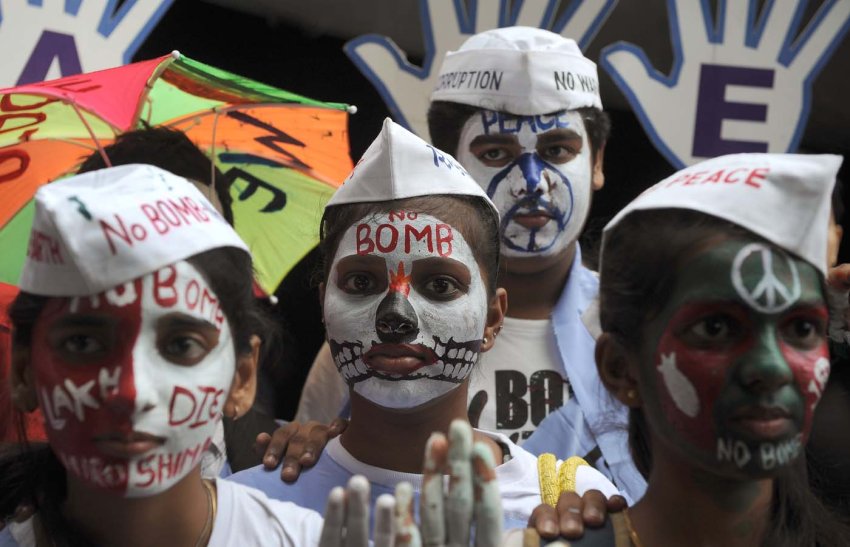
Seventy years ago, two split second explosions changed the course of history. The blinding light and fireballs that scorched Hiroshima and Nagasaki marked the start of the atomic age. More than 200,000 people died either instantly or within a couple of months. Thousands more have died in the years since due to the radiological impacts of the bombs.
More than 2000 nuclear “test” explosions have been conducted worldwide since the bombings in Japan on August 6 and 9 in 1945. In the 1950s and 60s, 12 major nuclear tests were conducted in Australia — on an island in Western Australia and in the South Australian desert at Maralinga and Emu Field.
Vast areas of land are still contaminated. Among Aboriginal people and Pacific Islanders, countless stories document the harm caused by nuclear tests.
Yami Lester, a Yankunytjatjara elder, was 10 when a nuclear test at Emu Field produced a low-lying cloud of fallout, a “black mist” that rolled across the land to his home 160km away. Speaking of that day, he said: “Some older people, they died. They were too weak to survive all of the sickness. The closest clinic was 400 miles away.”
The legacy left by decades of experimenting and testing nuclear weapons can never be undone. But the end of the atomic age could be closer than we think.
At the height of the Cold War, there were about 70,000 nuclear weapons, with several thousand of those on hair-trigger alert and targeted on cities and homes in other countries. There remain more than 15,000 nuclear weapons in the hands of nine countries that are reluctant to relinquish their nuclear-armed status.
As international momentum builds for a treaty to comprehensively ban nuclear weapons, placing them on the same legal footing as the other weapons of mass destruction — biological and chemical weapons — those countries with nuclear weapons will come under increasing pressure to disarm.
The Nuclear Non-Proliferation Treaty (NPT) came into force in 1970. It is a treaty designed to stop the spread of nuclear weapons; but it promotes the sharing of nuclear technology for "peaceful purposes". These two objectives are contradictory. It is much easier for a country with a nuclear power program to develop nuclear weapons.
Article VI of the treaty places an obligation on states to pursue negotiations in good faith for nuclear disarmament. None of the NPT signatories that have nuclear weapons —known as the P5 — have fulfilled this obligation. None have even come close. All are modernising their arsenals and have plans to keep them for decades to come. They've interpreted the treaty as permitting them to keep their weapons forever. However, as UN Secretary-General Ban Ki-Moon said, “there are no right hands for wrong weapons”.
We need a binding international instrument that will outlaw nuclear weapons. Of course, a treaty will not eliminate nuclear weapons overnight, and it is unlikely that countries with nuclear weapons will sign it. However, they are far outnumbered by the many countries that do want real action.
A ban would fundamentally change the state of play in many ways. Countries in ambiguous positions — such as Australia — would be forced to choose: are they for nuclear weapons, or against? European nations that host US nuclear weapons on their soil would be under intense pressure to end this practice. Financial institutions would be compelled to divest from companies that make nuclear weapons. Nuclear-armed states would find it increasingly difficult to modernise and upgrade their arsenals.
International discussions about nuclear weapons have shifted significantly. Three intergovernmental conferences have been held since March 2013 — in Norway, Mexico and Austria — to discuss the humanitarian impact of nuclear weapons.
After the most recent conference, the Austrian government introduced a pledge to “fill the legal gap for the prohibition and elimination of nuclear weapons”. Six months later, 113 countries have joined that pledge and committed to a process to outlaw nuclear weapons.
Australia has consistently opposed progress towards a ban treaty. Continuing to claim reliance on the US nuclear arsenal hijacks any meaningful effort towards disarmament. Instead of providing security, the thousands of nuclear weapons make our world less safe.
We need to make it clear that we reject nuclear weapons. We need to put a magnifying glass on Pine Gap, its role in the US nuclear war machine, and to the uranium mines that facilitate the flow of fissile materials worldwide.
The majority of nations have had enough of the nuclear colonialism that has dominated disarmament inaction for decades. On this 70th anniversary of the days the Japanese cities of Hiroshima and Nagasaki were immortalised in nuclear war, it is time we moved beyond the Cold-War thinking that tolerates these abhorrent weapons. We can demand the end of the atomic age. It’s time to ban the bomb.